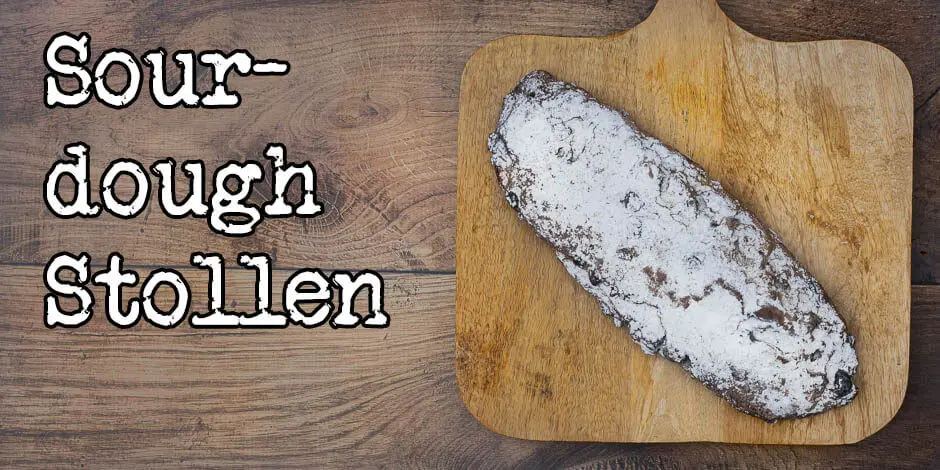It’s the month of Christmas and it’s cold and dark outside. You sit inside in your cozy, warm house with the lights on and the candles lit. The kettle is on for your favorite cup of tea or a nice fragrant cup of coffee. You cut a piece of stollen and life is good. This is my recipe for sourdough stollen.
Stollen is a German Christmas treat also known as Christstollen or Weihnachtsstollen. It’s gained popularity outside of the German-speaking countries over the last 30 years, especially in the United Kingdom.
Most people just buy their stollen, but stollen is not difficult to make. It may be a bit denser than the factory-created bread, but they are also loaded with flavor.

I’ve made recipes for other German baked goods since my father lived in Germany from around 1980 to his death, so I’ve spent quite a bit of time in Germany and have fond memories of this cuisine.
If you are just here for the recipe, you can press the button underneath to be automagically transported to the recipe:
Jump to Recipe Jump to VideoThe history of stollen
Stollen has been made for many hundreds of years.
Some historians believe that the first stollen came by as a result of a contest held by the Bishop of Nauruburg in 1329.
This stollen was very different from what we make today. The main ingredients were flour, oats, and water and were probably a lot coarser and tougher than a modern stollen.

The butter letter
In the 15th century, Prince-Elector Ernst and his brother Duke Albrech decided that it would be better to use butter instead of oil since oil was a precious commodity and expensive to make.
They wrote the current Pope Nicholas V who did see it their way, so 5 popes and 40 years later they finally got the okay to use butter which was sent to them as a letter, nicknamed the butter letter.
The letter only granted the Prince Elector and his household to do this free of church taxes. Everybody else was going to have to pay an ⅛ of a Gulden per year to do so.
When Saxony converted to Protestantism the stollen finally became free.
Over the years the stollen has changed from a simple bread to a sweeter and enriched bread with all sorts of sweet goodies.
The stollen formula of this sourdough stollen recipe
Vitals
| Total weight | 1760 grams |
| Pre-fermented flour | 60% |
| Hydration | 48.3% |
| Yield | 1 stollen |
The Levain
To mitigate the problem of getting an enriched dough to rise this bread has a whopping 100% inoculation, so the levain is quite large.
A bit of sugar is added to sweeten the sourness and it is also very important that you use the levain near its peak and not let the acidity grow before using it.
The hydration of this starter is around 62.3% which means that you need to knead it instead of mixing it, which you are probably used to with your 100% hydration starter.
| Weight | Ingredient | Baker's Percentage |
|---|---|---|
| 250g | all-purpose flour | 100.0% |
| 10g | sugar | 4.0% |
| 250g | sourdough starter (100% hydration) | 100.0% |
| 120g | skim milk (0.5%) | 48.0% |
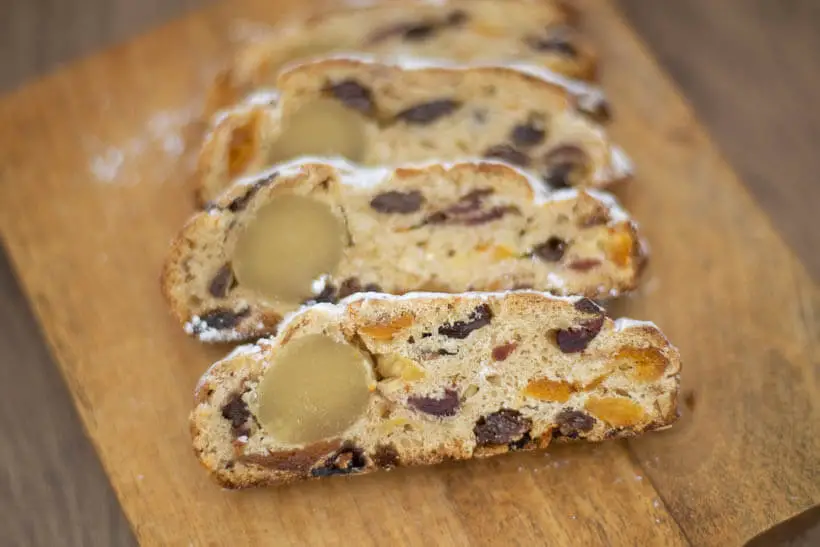
The dough
The dough for the bread in this sourdough stollen recipe is enriched using milk and butter. Both will help soften the crust and the crumb of the bread.
Furthermore, the flour of choice for this recipe is all-purpose flour (also known as plain flour) to also help get a softer crust and crumb.
| Weight | Ingredient | Baker's Percentage |
|---|---|---|
| 40g | sugar | 16.0% |
| 10g | table salt | 4.0% |
| 250g | all-purpose flour | 100.0% |
| 50g | skim milk (0.5%) | 20.0% |
| 150g | butter, salted | 60.0% |
| 250g | marzipan | 100.0% |
| 360g | dried fruit | 144.0% |
| 8g | lemon zest | 3.2% |
| 12g | orange zest | 4.8% |
Traditionally candied orange and lemon peel are added to the dough, but in my version of stollen, I use the regular zest, which gives a wonderful zing and a good opposing taste to all the sweet fruit.
I soak the dried fruits in wonderful spiced Caribbean rum, but you can also use brandy or another spirit. If you don’t want a stollen with alcohol you can soak the fruits in water to make sure they are plump.
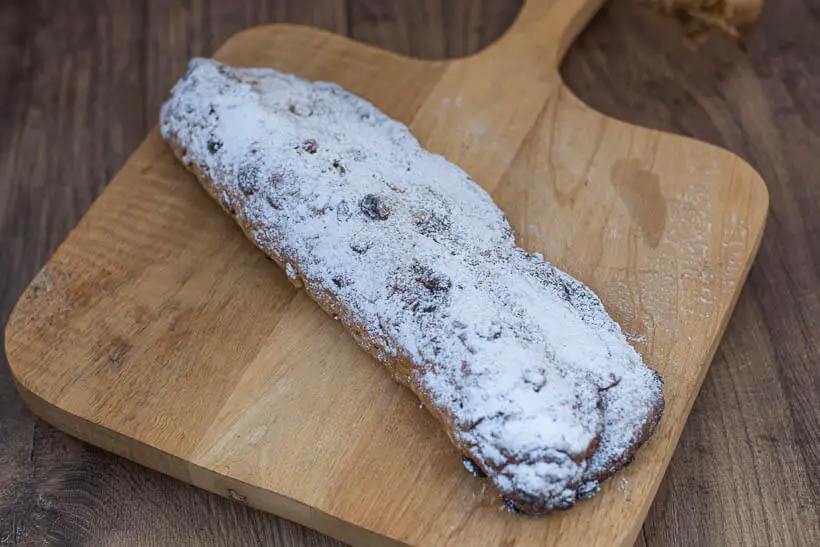
When it comes to marzipan, it’s not a stollen without marzipan. Make sure you buy good quality marzipan made with real almonds as the other stuff is really no good.
If you want to change the formula around or change quantity, you can do so here in my Bread Calculator.
The conclusion of this sourdough stollen recipe
A stollen is supposed to be flat, drenched in confectioner’s sugar, and have a good amount of marzipan and delicious rum-soaked dried fruits in every bite.
This stollen lives up to every one of those statements. On top of the zing of the zest is a very welcome fresh breath of air in an otherwise very rich and sweet environment.
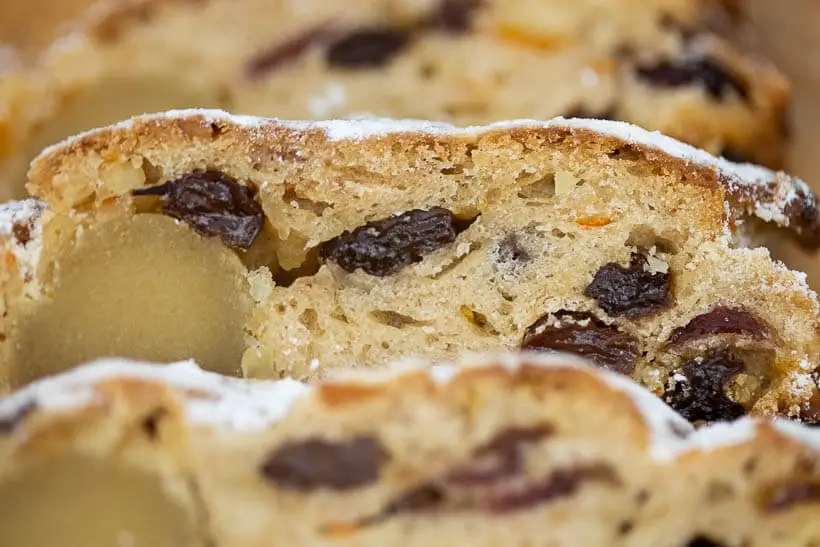
For a sourdough endeavor, it is relatively easy to make. Although it doesn’t rise as quickly as a yeasted version, the actual bread has a nice and well-developed flavor without any residual acidity.
For me, it’s not Christmas without stollen, and this is my absolute go-to recipe for delicious stollen.
Please share this recipe for sourdough stollen on social media
This is my recipe for sourdough stollen. If you like the recipe please consider sharing it with like-minded bread lovers on social media.
If you make it and post it on Instagram, please tag me as @foodgeek.dk so I can see it. That would make me very happy.
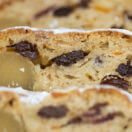
Sourdough Stollen
Ingredients
Levain
- 250 g all-purpose flour
- 10 g sugar
- 250 g sourdough starter
- 120 g milk
Dried Fruit Soaker
- 100 g sultanas
- 100 g raisins
- 100 g dried apricots
- 60 g dried cranberries
- 100 g spiced rum
Dough
- 40 g sugar
- 10 g table salt
- 250 g all-purpose flour
- 50 g milk
- 150 g butter
- zest of 2 lemons
- zest of 3 oranges
- 40 g almonds
- 250 g marzipan
Topping
- 50 g butter
- 50 g confectioner's sugar
Instructions
Prepare levain and soaked fruit (the night before)
- To a small bowl add: 250g/1¾ cups all-purpose flour, 10g/2 tbsp granulated sugar, 250g/1 cup stirred down starter and 120g/½ cup milk.
- Mix it until it comes together, move the dough to the counter and knead it until everything is throughly combined.
- Then put the levain in a jar and let it grow to about twice the size.
- It took about 12 hours for my levain at around 21°Celsius/70°F.
Soak fruit
- To a small bowl add: 100g/3½ oz sultanas, 100g/3½ oz raisins, 100g/3½ oz finely chopped apricots, and 60g/2 oz dried sweet cranberries.
- Pour over 100g/½ cup spiced rum. If you don’t want the bread to be alcoholic, use water instead.
- Mix them up, cover them and leave them until you need them.
Mix the bread (the following morning)
- To a bowl add: the entire levain, 40g/⅕ cup granulated sugar, 10g/1½ tsp table salt, 250g/1¾ cup all-purpose flour, and 50g/⅕ cup milk.
- Mix it until it comes together.
- Then dump it out of the counter and knead it until all the flour has been hydrated. The dough will seem very dry here.
- Put it in a bowl, cover it and let it rest for one hour.
- Then take 150g/⅓ butter out of the fridge and cube it.
Knead in the butter
- When the hour is up, knead the butter into the dough.
- Let the dough rest on the counter for about 15 minutes.
- While the dough is resting, sieve the dried fruit, and pad it dry with kitchen paper.
- Also zest 3 oranges and 2 lemons and put it into a bowl.
- And chop 40g/1½ ounces of blanched and deskinned almonds finely.
Add inclusions
- When the dough has rested, press the dough out into a rectangle.
- Add a third of the zest, a third of the almonds, and a third of the fruits.
- Roll up the dough and knead it until the fruits are kneaded into the dough.
- Continue two more times until you have a nice dough with both fruit, almonds, and zest inside.
- Put the dough into a proofing container and let it rise until almost doubled.
- It took about 6 hours for me at 21°C/70°F.
Divide and shape
- When the dough is ready, divide the 250g/9 ounces marzipan into two and roll them out into cylinders of about 25 centimeters/10 inches long.
- Then grab the dough and divide it into two equally sized pieces and tease one of them into a roundish rectangle of about 30 cm*20 cm/12"*8".
- Using a rolling pin, make an indentation the long way in the middle of the dough.
- Add the marzipan roll and seal up the dough with the palm of your hand.
- Add the dough to a parchment-lined cookie sheet.
- Shape the other piece of dough the same way and add it to the cookie sheet.
Final proof
- Cover them with plastic wrap and let them proof somewhere warm for an hour.
Heat oven
- After the hour is up, remove the doughs and heat the oven to 170 degrees Celsius/340 degrees Fahrenheit.
- If you have fan assist, use it, if not you probably have to turn the cookie sheet around halfway during the baking.
Bake
- When the oven is warm, add it to the oven and bake for 45 minutes. If, during the baking, the bread is starting to get too brown, cover it with aluminum foil.
- About 5 minutes before it’s baked, melt 50g/3½ tablespoons of butter.
- When the stollen is baked, grab it from the oven and put it on a wire rack, and brush them both with melted butter.
- Leave them to soak for about 5 minutes, and then dust them with confectioner’s sugar.
- Now leave it to cool, and it’s ready to eat.



